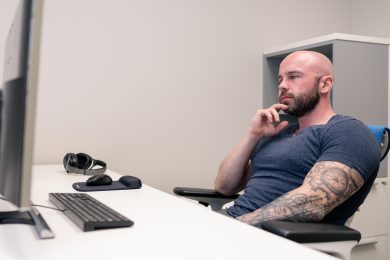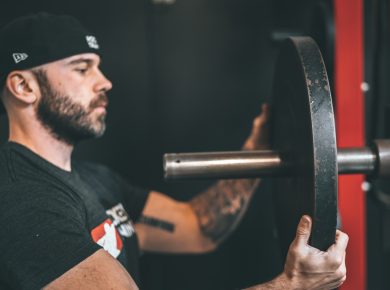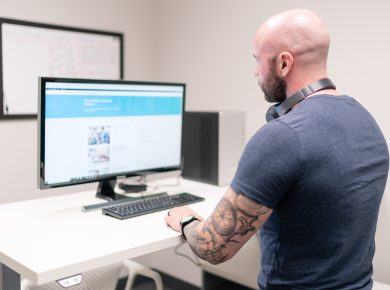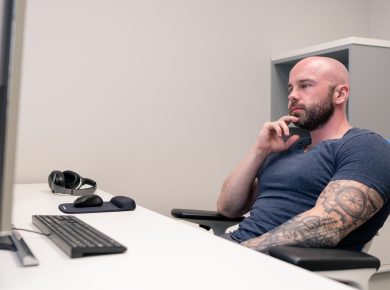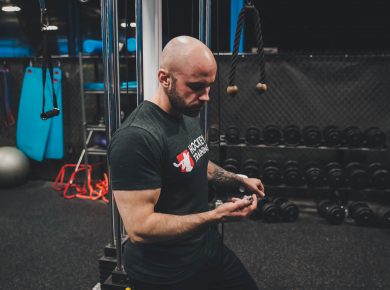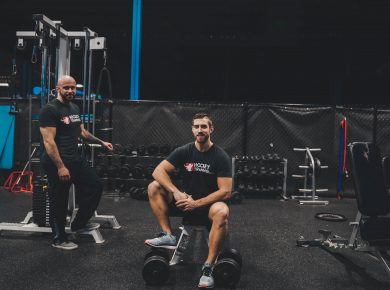Introduction
In this article, I’m going to show you the exact steps to take in order to provide a world-class experience for your clients while still keeping yourself from getting stressed out, anxious, or over-worked.
Trust me, I’ve been there.
I first got into the online coaching world sometime in 2011-2012, and at the time there was no guidance being offered at all on how to structure your business in an efficient and professional way.
I learned through trial and error at the expense of my early clientele’s time and money, and that didn’t sit well with me.
I knew if I didn’t “clean things up” with my business systems that I would come off as an unprofessional coach who couldn’t deliver real results to his clients — and that’s the last thing I wanted people to see me as.
I sought guidance from mentors, joined many educational programs/masterminds, and adopted principles from other industries and brought them to the online health industry to improve my output.
Over time and through some growing pains I figured out an excellent system that I still use today with everyone from the stay-at-home mom to my world champion athletes and Hollywood actors.
No matter who comes my way, they undergo this onboarding process that you’re about to learn 100x faster than I was able to create it over years of trial and error.
Let’s get into it.
Services And Pricelist
If you don’t already have a professional-looking PDF that outlines all of the online coaching services you offer then this is the first thing you need to do after reading this article.
At this point in time most people think:
Dan, why don’t you just post your services and pricelist directly on your website so people can look at it without contacting you?
That’s a great question.
In my experience, you never truly close the sale until you demonstrate that you can be the solution to the prospect’s particular problem and/or pain points.
Nowhere can you do this more efficiently than through a direct conversation with the prospect.
This is how you convert someone from a prospect into a customer.
Allow them to contact you and ask what services you offer, then at that point in the return email, you can attach your services PDF but then also ask them what their particular goals are.
Once they reply, you demonstrate that you’re “the solution” to their unique problem and 9/10 you’re going to have an easy close to that sale.
By “demonstrate” I mean that you could talk through how you’re going to approach it and why you will be successful with them, or, you could simply direct them to a testimonial you have received that’s relevant to the same goal they are trying to achieve.
For bonus points, do both.
In any case, by forcing people to contact you for your services/pricelist PDF you engage with them on a much more personal level then if they just visited your website and saw a cookie-cutter pricelist for what you offer.
Now, for products it’s no problem at all to just list them on your website (eBooks, cookbooks, programs with no actual coaching, etc.) — but for services, it’s best to get personal as soon as possible because these a typically higher-ticket items that need more convincing the get the close.
Some other people may have a different approach to this, but in my opinion, a few emails are well-worth it since that client could easily be worth many thousands of dollars to you as the months/years go on.
With that said, your services/pricelist PDF should include:
- All of the coaching services you offer
- The exact price of each service with no hidden fees
- A detailed description of each service you offer and what exactly it contains
- Any upsells/add-ons you may offer
- A brief outline on why online coaching is superior to coaching in-person
- Be sure to include “one-time” options as well as “Commitment” options that offer people a slight discount if they commit with you for a certain period of time (typically 3-6 months)
If you have all of the above within your PDF document and you combine it with the sales process I outlined above you are putting your client in a very natural position to pick what’s best for them to move forward in the coaching process with you with minimal resistance.
Intake/Assessment Process
The intake and assessment process you undergo with your clientele can go in one of many different directions.
Some coaches keep things super simple with just a few questions about their current body composition and lifestyle.
Other coaches get a little bit more comprehensive and want access to a food log as well as have the client perform and record a series of movements for structural balance testing.
Lastly, the most comprehensive you can possibly get is to do all of the above but also include a lab analysis package on top of that which involves blood, urine, saliva, or stool testing (or, all of the above).
For 99% of the coaches out there, I like a “middle of the road” approach for them.
Meaning, they should have a comprehensive questionnaire and food log, but, the structural balance testing and/or lab analysis is normally unnecessary unless you’re working with a very high-level client whose livelihood depends on their performance and/or aesthetics.
A well-designed questionnaire in combination with a solid foundation of knowledge is almost always enough information by itself to create an optimal program.
A good questionnaire can give you data on electrolyte status, blood pressure, medications, goals, motivators, limitations, strengths, food they do/don’t enjoy, current symptoms, where they have plateaued in the past, their current emotional pain points, etc.
This gives you more than enough to work with in order to create an optimal program, from there, it’s simply ongoing communication to dial the process in further (if necessary).
Here is free access to a video lecture I did for my Ultimate Nutrition Mentorship students teaching exactly how to use it in their practice to get the best results for their clients.
Between that questionnaire and the accompanying lecture, you will have everything you need to create an extremely professional intake and assessment process.
Beyond this, I would highly recommend that once you receive an inquiry from a prospect you immediately put in your Google calendar to follow up at the 3-days and 7-day mark.
You want to keep them engaged with you throughout this process — selling is an emotional thing and not a logical thing. This means that you need to close the sale before the excitement wears off and they lose motivation towards working with you.
On the day they inquire you’re going to send through that PDF we discussed above, and then three days after that you’re going to check in with them and see if you can field any more questions they might have (to overcome any objections to the sale). Then, repeat that process again on day 7.
Two follow-ups is the perfect amount to not come across as annoying/pushy, yet, still close 50% more sales than you otherwise would have.
Payment Process
When you close the prospect on the sale you want to get the money as soon as possible from them.
Just because they have agreed doesn’t mean they won’t back out, you need to collect the money from them while they are still emotional about the process.
If you delay/procrastinate this part I can guarantee you that you will lose out on a lot of clients because you left too much time for them to change their mind.
I have been using PayPal my entire career for my 1-on-1 services, and for larger-scale products like Hockey Training programs I use ClickBank.
ClickBank is perfect for the large scale products because you collect money right away in a simple checkout cart.
Whereas with 1-on-1 coaching, I have always liked PayPal because in 10 seconds I can send them an invoice for the amount of the coaching process and they can pay through that invoice with any credit/debit card and they don’t even need a PayPal account in order to do so.
Beyond this, PayPal also allows you to create automated payment plan options on a single invoice as well so you can customize it any way you want in a super user-friendly manner.
You can also add your own logos to PayPal invoices so they look much more professional.
A word of caution though…
Do NOT make your clients program until they have paid.
I have made this mistake in the past where someone says something along the lines of “I get paid this Friday, and then I’ll shoot it over to you!”
And then I make their program only to have them disappear after that. Now, I don’t even begin thinking about their program until I have collected the money.
At that point, I begin creating their system — which leads me perfectly into the next section.
Creating Your Client’s New Program
I am about to say something that makes some coaches very upset…
It is completely OK for you to have pre-made training templates created for your clientele.
In fact, I would say there is a huge argument on how it’s more beneficial to have a library of templates rather than create something from scratch every single time you get a new client.
If you create a new program completely from scratch every single time you get a new client, you will be spending a ton of time doing the small tasks that you’re not paid for (i.e. typing out sets, reps, and exercise names on a spreadsheet) rather than the knowledge that you are paid for (i.e. knowing the strategy and system they need for success in their specific context).
Meaning, if you already have a periodization framework that you know you like your “beginner” clients to go through, why create it from scratch each and every time you get a new client?
You would save a ton of time and effort having the workouts/phases already completed and then just adding the name/date once you send it to your client.
“But Dan, isn’t this like giving them a cookie-cutter program?”
No, it’s not.
Handing out cookie-cutter programs means that you would be giving out one program to all of your clients regardless of context.
What I’m telling you to do is create context-specific templates and then save them on your computer so you can pull them out and use them when you have a client that fits perfectly into that system.
For example, if you are well-known for working with post-pregnancy Mom’s who want to get their pre-baby body back — then you already have a system you KNOW works well.
You understand their different hormonal balance, you understand their bone structure has changed, you understand they may run into craving-control issues, and you understand that stress management is key during these times.
Your exercise selection, volume prescription, nutritional guidelines, and periodization (at least for the next 3-Months until they get their fitness back and may change their goal at that point) are going to be nearly identical from one mom to the next.
So, why try and reinvent the wheel every time, when you can instead:
- Use a system you know without a shadow of a doubt produces good results
- Send it to your client faster than you otherwise would have which improves their customer experience
- Use testimonials from previous people on this same system to close your sale easier
- Place less stress on yourself
- Place less time demand on yourself doing small tasks rather than the “big picture” thinking you’re actually paid for
“Ok, that all makes sense Dan. But earlier you said it’s MORE beneficial to have templates. How could that possibly be true?”
A template is not a PDF, you can still make changes to it.
Meaning, you have the original skeleton of the volume, frequency, intensity, exercise prescription, and periodization all in place.
That alone just saved you 90% of the time it’s going to take you writing this thing from scratch, but since you are able to still edit it you can make changes where necessary.
Bad lower back?
Adjust exercise selection accordingly.
Need to rehab shoulder?
Adjust exercise selection accordingly.
No matter what the context is, you can make small adjustments to the original template that you have.
I think this is MORE beneficial for our clients because of the level of energy we have now towards the customization of their program design.
You know how in video games you have a full bar of green health in the top corner?
Think about that like it’s your “energy bar” for how much energy and attention to detail you bring to the table when sitting down to write a program.
If you have to write the whole thing from scratch every single time, your green bar of energy is going to be wasted on things that should have never taken energy from you (i.e. starting from a blank sheet).
Whereas if you’re starting already with a full program design in front of you, you don’t have to calculate ANYTHING and you can instead focus exclusively on customizing the program for their exact needs (while still saving loads of time).
In the end, your client receives your attention to detail where it mattered most plus they get their program sent to them twice as fast.
That’s what I call smart and effective coaching.
How should you apply this?
Think about the top 5 demographics that come your way the most often and create 3-6 months of periodization templates for them in advance so you can use your green energy bar of creativity on truly customizing their approach rather than just punching buttons on a keyboard.
Setting Expectations
Everyone wants results right now, if not yesterday.
Entitlement is a key thought here. Modern advances in technology have brought us things so rapidly that our patience and respect for hard work is completely shot.
When a person gets a training certificate just for showing up, good luck telling them to work hard to enjoy the fruits of their labor.
This is why you see so many trainers coast their entire career doing the bare minimum of continuing education.
Our clients are the same way, they think just because they spent the money on you that the results are just going to magically start happening without them having to change their lifestyle.
In a fitness culture that keeps promoting fast results, real coaching is becoming a lost art.
Do you want to lose weight?
Here’s the secret…
It’s going to take a lot of hard work and time to start seeing results.
Do you want to double your results and get to your destination faster?
No problem, all you’re going to have to do now is put in twice the amount of hard work and time.
Some people don’t like to hear that, but it’s important to never mistake simplicity for easiness.
Losing weight is simple, but it’s certainly not easy — and it’s definitely not something that magically happens once you pay your coach for a new plan.
Things take time, most of your clients will not have the patience it takes to get great results.
This is what you have to address first, because if they don’t have the patience to let things slow cook and form then they can just expect a life of continuous failure.
It took time to learn how to walk.
It took time to heal from your first heartbreak.
It took time to finish school.
It takes time to finish anything worth accomplishing, that’s why it’s so satisfying in the end.
Our clients need to get started on their journey with the correct mindset and stop thinking that other people are “lucky” if they got themselves in shape.
Luck is nothing more than preparation meeting opportunity.
Our clients all have greatness in them and they need to train their mental-muscles to see what their true potential is.
This is why we need to set the expectations early.
Sit them down and be realistic with them.
Set realistic goals, offer a realistic timeline, and create a sustainable schedule that they can adhere to for the long-term.
I personally send my clients a “New Client Info” sheet that I offer the students of the How To Be A Successful Online Coach course that sets the expectations and the boundaries straight away.
This type of action keeps you sane because the expectations of how the coaching process is going to be laid out immediately, but, it also gets your clients in the mindset they need to be in without having a “right now” mentality attached to it.
If you don’t have an “expectations sheet” or even a contract that you have your clients sign where they “agree” and commit to a structure of coaching and mentality, then you need to put this on your to-do list right away.
It should include:
- When and when they can’t contact you
- Where and where they can’t contact you
- How often they need to update you
- How the update should be structured
- What type of mindset do they need to accept starting out on their journey
- Recognize what mistakes they have made in the past and work to not make them again in the future
- What type of biofeedback cues they should be paying attention to
- What type of objective cues they shouldn’t be paying attention to (i.e. the scale)
I also recommend being slightly stern about your position in the relationship, for example, here is a copy and paste from a section in my person New Client Info sheet that I send to my clients:
IMPORTANT: Coach does not mean “friend” or “cheerleader” – My job is to stay on top of you doing yours. I will always be upfront, honest, and frank. Expect that from me. Having said that, know that I am ALWAYS on your side. I say what needs to be said, and it’s not always what someone wants to hear. A good coach is objective, and honest. That is what you will get from me. If you are slacking or performing weakly, expect me to tell you. A good trainee/client will handle criticism knowing it may be a hard pill to swallow, but is always for their own good.
…that statement may seem harsh to some, but, it sets the expectations straight away so my clients think:
- He might be harsh, but it’s for my own good
- He is always on my side no matter what
- I will now not be surprised, offended, or “lash back” at Coach Garner if he says something bluntly because the expectation what set straight away
You can create your sheet however you want to create it based on your own coaching style, but I urge you to create it because setting the expectations is so critical for long-term success.
Afterall, unhappiness only occurs when your expectations don’t meet your reality.
But if you set the expectations from the word go, then you can never lose.
Ongoing Communication
As any good coach understands, ongoing communication with your clientele is a vital component towards their long-term success.
Communication allows you to adjust the program when necessary so that they never run into a plateau, but, it also offers you the opportunity to educate them in the areas where they need it most.
Communication is key, and although most coaches understand this, they drive themselves into exhaustion by not setting a system and/or boundaries in place for when and how this communication takes place.
For example, it’s very common for a coach to offer “unlimited communication” as a tactic to close more sales.
This concept sounds nice to you because you think you’re being a better coach this way, and it sounds nice to your client because they think they are getting more in return for the money they are spending on you.
But, one thing I can tell you right now without a shadow of a doubt is that you’re going to have clients who will drive you absolutely insane by communicating with you repeatedly and excessively every chance they get.
Emotional breakdowns, random questions, and irrelevant updates are their weapons of choice and over time, even though you wish nothing but the best for these individuals, you end up resenting them.
The whole reason you’re on a site called Create Freedom is because you want more freedom in your life. Both personally and professionally.
If you’re getting into the online training world you have to make sure that you are creating a business and not a job.
Being a servant to 200 emails and text messages everyday is a job, not a life (or) scalable business venture.
You will run into the feeling of “coaching burnout” where you begin to lose a passion for helping people and every email/text seems like a total chore to answer.
Not to mention, this unlimited support that you think is so good for your client isn’t actually as beneficial for them as you think.
Unlimited support transforms you into a crutch for them.
If they are going to succeed in the long-term they can’t have a dependency on your existence.
The instant gratification/answers they get when you’re around will be gone once the coaching package is over.
At this point they will realize that the only healthy habit they developed throughout the process was messaging you every day to sweep in and save the day.
Your 24/7 on call schedule didn’t allow them to learn, grow, or develop their own habits.
The end result?
You end up burnt out and your client ends up unsatisfied with your service despite how many hours you put into them every single week.
If any of this sounds familiar to you, you won’t ever have to feel this way again if you set up a proper structure for your ongoing coaching communication.
Before we get into structure, I want to point out that you should have “office hours” when your clients know you’re available — and this information should be found within your “New Client Information Sheet” that I outlined in the previous section.
This alone saves you a ton of time and stress because you can set your office hours for ongoing support during the schedule windows you have where you won’t be distracted by other tasks.
I have a Google Calendar system that I personally use that I outline in the How To Be A Successful Online Coach course and it allows me to “be in the moment” on whichever task I am doing.
This way I am not answering client questions while creating content (which would reduce the quality of my content) and I am not creating content while answering client questions (which would reduce the quality of my coaching).
Time slots are chosen ahead of time for when I am going to focus on certain tasks which allows me to bring my best self no matter what task is in front of me.
Remember, happiness and satisfaction are only ever reduced when your expectations don’t meet your reality.
When you set the expectations of office hours immediately in the coaching process your clientele will never be disappointed if they don’t hear from you ASAP because they already know in advance when you’re available and when you’re not.
When you do things this way you don’t have to feel guilty anymore for not answering an email after 5pm or during the weekends — the expectations have been set ahead of time and it works out better for both you and your client.
It works out better for you because you’re less stressed and it works out better for your client because now they have to problem solve on their own until your next open office hour (which is how they are going to learn the real habits that will bring them success for life).
From a systematic structure standpoint of delivering high-quality coaching communication to your online clientele, I recommend going only one of three ways:
- Email support
- Phone/video calls
- Facebook group
Going with Email only works very well for most coaches and it’s the most popular route for 1-on-1 online coaching.
If you go the email-only route, I would recommend offering an upsell that includes coaching calls (either video or phone) or a weekly/monthly basis depending on their needs.
This allows you to get more revenue upfront if they choose to go with it, but, also allows your clients who don’t have a big budget to still be able to get the 1-on-1 attention they need from you through email alone.
I personally love the email-only route and it’s something I have been doing for 80%+ of the clientele I work with across my entire career.
I have my clients fill out a “Weekly Sunday Update” that they must complete and send to me every Sunday.
I set it up to be completed/sent on Sunday from my clients so that I have everybody’s update at the same time during my morning office hours on Monday and can knock them all down at once in a low-stress, systematic way while simultaneously setting them up for success during the week as they got answers out of me first thing Monday morning.
Although, a few caveats are in place to remove “noise” from the emails and save both me and my clients a lot more time — the rules of email engagement with me are:
- My email clientele can never text/call me, communication is done via email only
- My clients can send me emails any time during the week but they know I will not answer until my next available office hours
- Their question/comment must be “to the point” and not sandwiched by small talk (if it’s not a Sunday update email)
- Their Sunday update email must also be “to the point” and not sandwiched by small talk
My clients know that I’m available if they have an emergency, but, anything beyond that is kept strict and brief.
Why do I do this?
Because I want to be as effective as possible.
When I answer emails I shut off every other part of my life, put on some ambient music in the background and answer them all in one shot.
This allows me to “be in the moment” while coaching them and also saves me a ton of time because I’m not answering emails here and there throughout the day/week.
Beyond this, the strictness behind telling my clients to “get to the point” eliminates the unnecessary information and also saves them time because most of them have lives as well and they don’t want to feel obligated to write an essay every time they contact you.
Email efficiency allows you to scale your business in a stress-free manner, provide better service for your clients, and save everybody a whole lot more time.
When it comes to phone/video calls, once again, the name of the game is efficiency and quality.
At some point you have likely heard of Parkinson’s Principle, it represents the idea that a task will expand to the amount of time that is allowed.
Nowhere is this more true than with coaching calls (except maybe business meetings, but that’s a conversation for another day).
If you give a client an hour to talk on a call, they will talk for the full hour.
If you give them 30 minutes, they will take the full 30 minutes.
If you give them 15 minutes, you’re going to find out how efficient conversation can really be when you eliminate the noise and get straight to what’s important.
This is exactly why I recommend all of your client check-in calls to be scheduled for a 15-minute time limit (the sales call can be longer, I am strictly talking about once they are already a client right now).
Each time you go through an update with them, you will ask the same questions, but your questions will vary depending on what their goal is.
Here is an example of a question list you would have for a health-based client (i.e. not after any drastic physique transformation or performance goals, just wants to feel/look better).
- How has your energy been this week?
- How has your digestion been this week?
- How has your sleep been this week?
- Do you have any events coming up?
- Is there anything in your plan that needs reworking?
I would recommend you keep your client calls to 5 questions or less, and make a template just like this for each of the demographics you work with most (just like we discussed in the program design section).
Since the calls are only 15 minutes, it becomes easy to perform them every week which then becomes a major selling point on during the sales process when they discover that they get weekly calls with you.
Furthermore, I highly recommend using an app called Caledly as it eliminates all of the back and forth communication that’s involved in scheduling a call.
Instead of going back and forward, your client can view your calendar and book a timeslot within your available office hours without any communication needed.
Finally, if you want to utilize Facebook Groups as part of your ongoing communication strategy you have to be a little careful because it comes with both positives and negatives.
The positives include:
- Everybody already has Facebook, so it’s easy for them to navigate/access
- It creates an opportunity for you to develop a positive community where everybody encourages each other
- Some people in the group will become advanced with your methods and will be able to answer questions for you in there
- It costs you nothing
The negatives include:
- Many more notifications per day
- Possible “bad apples” infecting others with negativity
- Nothing is stopping Facebook from one day deciding to charge you to run this group
- You will need to moderate comments if your community becomes large
- You will need to have a system for adding/removing people based on where they are at in there coaching package and when it expires
- You can waste a lot of your own time on social media while telling yourself a fake story about how its “work”
Facebook groups work great for group coaching, transformation contests, or if you have a monthly subscription membership to your website and you offer a “VIP support group” for members-only on Facebook.
If you’re doing group coaching, I would make sure that you create different groups for different goals (i.e. don’t have a bunch of fat loss clients, weight gain clients, and athletes in the same group. It will become cluttered and will lack a “community” feel because everyone is on a different path).
If you’re doing a transformation contest, be sure to shut the group down at the end of the contest to prevent potential negative comments from those who didn’t get results or who thought someone else should have won.
If you’re doing a membership-based group, make sure you eliminate people from the group immediately if they have cancelled their membership on your website or else you will have someone receiving a ton of personalized value for free.
Closing Out The Coaching Package
Leaving a lasting good impression on your client who is about to finish their coaching package with you is something you need to prioritize if receiving referrals is ever going to be something you can expect.
Even if you get someone great results, they won’t always sing your praises elsewhere unless your services were professional from start to finish.
For example, let’s say you and your partner booked a date night at a nice restaurant.
They greeted you nicely at the door, you didn’t want long to be seated, the food was excellent, and the whole thing was fairly priced.
But, on the way out you saw a giant rat running in the kitchen.
Did the service and food meet your expectations?
Yes.
Will you ever recommend that restaurant to any of your friends or family members?
No!
Yet, I see “giant rats” everywhere in the fitness business. Mostly figuratively.
Examples include a gym manager being upset you’re cancelling your membership so they are rude during your exit process.
A personal trainer could be jealous that you’re leaving them for another trainer so they stop being your friend the moment you close your coaching package.
A nutrition coach thinks your new dietary approach is dumb so they act condecending when you tell them your decision to try something new.
The list goes on and on…
Listen, if you ever hope to:
- Receive a testimonial from this person
- Receive an online business review from this person
- Receive a referral from this person
- Work with this person ever again
…Then you need to prioritize your closing process to leave a good impression.
What do I do?
I keep things simple, scalable, and effective.
I have a “Life Beyond Working With Coach Garner” PDF coaching package that I send all of my clients once their coaching package expiration date hits.
It includes the following (in this exact order):
- A recap of the goals we set and why
- A section on how this process was about lifelong principles and not short-term results
- 15 life lessons on health and fitness and a full paragraph explanation for each one
- How they can stay healthy for life
- How they can stay connected with me
- A heartfelt and sincere thank you
The document looks very professional and is about 4000 words in length.
This took me a couple hours to write, yet, I’ve sent it hundreds of times because it’s scalable for any client who comes my way.
So, instead of being upset that anybody leaves me — I keep a big smile on my face and provide them EVEN MORE value on their way out the door so that they know I am someone they can trust to recommend a friend or family member to.
This is what I recommend you do as well.
A PDF is something you can make for free, its scalability is unlimited, and you will squash your competition because instead of seeing a rat on their way out the door — Your clients are getting the epic farewell they deserve and that will result in you having to spend way less money on advertising due to the amount of referrals coming your way.
Final Thoughts
The online training world sounds simple on the surface, but, there are many nuances involved in creating a business that allows you to scale in a stress-free manner while still providing a high-quality service.
Too often trainers kind of just “jump in” to the online world only to find that it’s a lot more complicated and difficult than they thought and that having the proper systems in place is critical to achieving the success and freedom that you desire.
I hope I was able to simplify the onboarding process with this article and that you now have a clear and simple path to take towards the onboarding process.
Then when you’re ready to transform your entire business to the next level and bring more success and freedom into your life than ever before through using our proprietary Freedom Formula, join the How To Be A Successful Online Coach course and I’ll see you on the inside!
